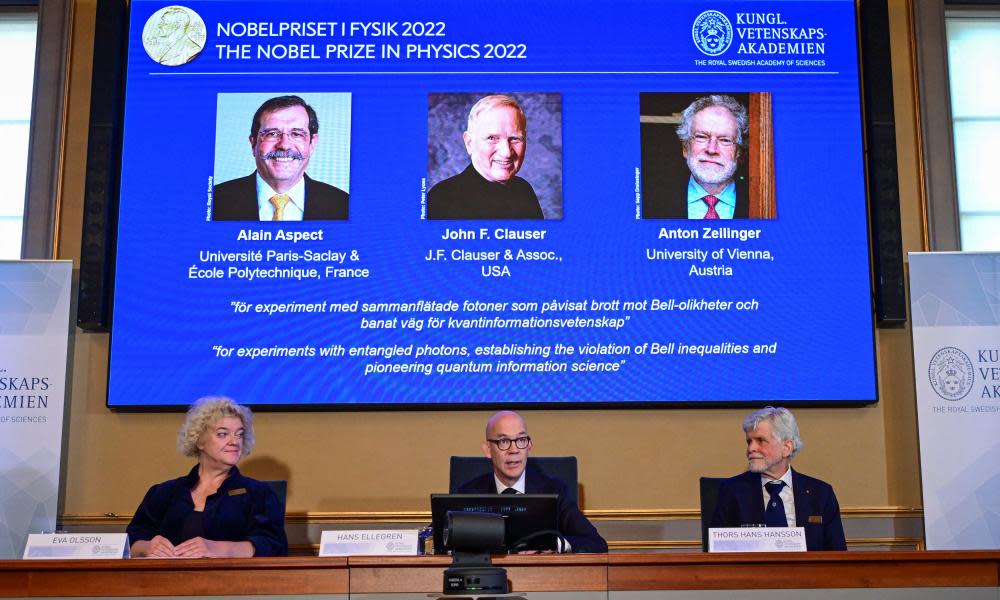Three scientists share physics Nobel prize for quantum mechanics work

The 2022 Nobel prize in physics has been won by three researchers for their work on quantum mechanics.
Alain Aspect, 75, John F Clauser, 79, and Anton Zeilinger, 77, have won the 10m Swedish kronor (£802,000) prize announced on Tuesday by the Royal Swedish Academy of Sciences in Stockholm. All three will receive an equal share of the prize.
According to the official citation for the award, the prize was given “for experiments with entangled photons, establishing the violation of Bell inequalities and pioneering quantum information science”.
The trio’s work has focused on a phenomenon known as quantum entanglement, which was dubbed “spooky action at a distance” by Albert Einstein. The research is expected to play an important role in quantum computing, secure information transfer, and sensing technologies.
Quantum entanglement, in a nutshell, means that the properties of one particle can be deduced by examining the properties of a second particle – even if they are separated by a large distance. As the academy pointed out, an easy way to imagine this is to think about being given one of two balls – one of which is white and the other black. If you receive a white ball, you know the other ball is black.
Importantly, however, the properties of each particle are not fixed until they are examined – in the ball scenario this would mean that both balls are grey until looked at, whereupon one turns white and the other black.
This lies at the heart of the “spookiness” – rather than “action” at a distance, the two particles, or balls, appear to be inherently connected, without the need for any signal to be sent between them.
One possibility mooted by physicists was that the particles might contain some secret information or “hidden variables”, that determine their properties. In the early 1960s, the Northern Irish physicist John Stewart Bell proposed that it would be possible to test this by carrying out multiple runs of a particular type of experiment and looking at the way the results are correlated, a theory that gave rise to what is known as Bell’s inequality.
Inspired by Bell’s work, the American physicist John Clauser, now at JF Clauser and Associates in Walnut Creek, California, conducted work with the late Stuart Freedman involving polarised light to show that particles, in this case photons, do not contain secret information. In other words, the balls in the scenario above do not contain hidden instructions about which colour to turn. Instead, as predicted by quantum mechanics, which one turns black is down to chance.
Not everyone was excited at the time. In an interview with the American Institute of Physics in 2002, Clauser recalled how his former thesis adviser Pat Thaddeus was far from impressed when Clauser first became interested in the field.
“He thought this was a terrible waste of [my] time, and I was ruining my career,” said Clauser.
Alain Aspect, now at Université Paris-Saclay and École Polytechnique in France, came up with further experiments – these closed important loopholes that might still have allowed the hidden variables theory to explain the results.
Among other work, Zeilinger and colleagues explored entangled systems involving more than two particles – leading to the first experiments involving quantum teleportation. The approach involved transferring the properties of a particle – typically a photon – across large distances to another particle. The work led to Zeilinger, who is known for being a jazz-lover, being dubbed “Mr Beam”.
Prof Jeff Forshaw, a particle physicist at the University of Manchester, said the award of the prize was terrific news.
“This is richly deserved because these are the pioneers of modern quantum physics,” he said. “Their experiments confirmed the most bizarre and possibly most important aspect of quantum theory – entanglement.”
Forshaw added that today, entanglement was the key resource being exploited by quantum computers and the bedrock of modern information theory, adding that given Bell’s pivotal contribution it was also right that he was mentioned in the award’s citation.

 Yahoo Movies
Yahoo Movies 
